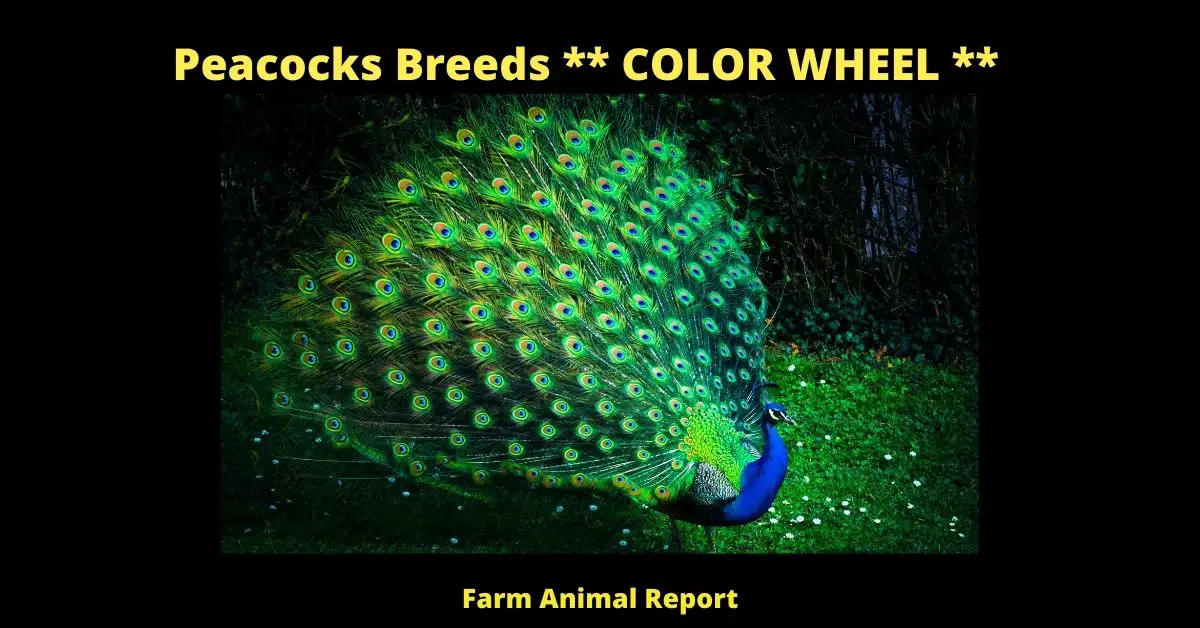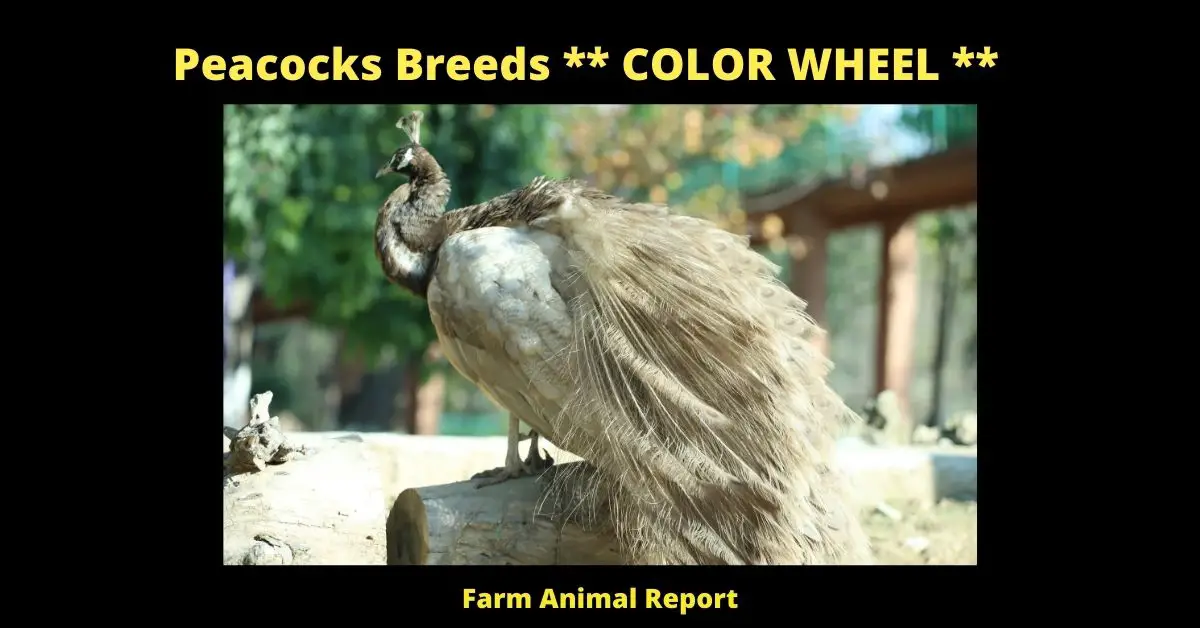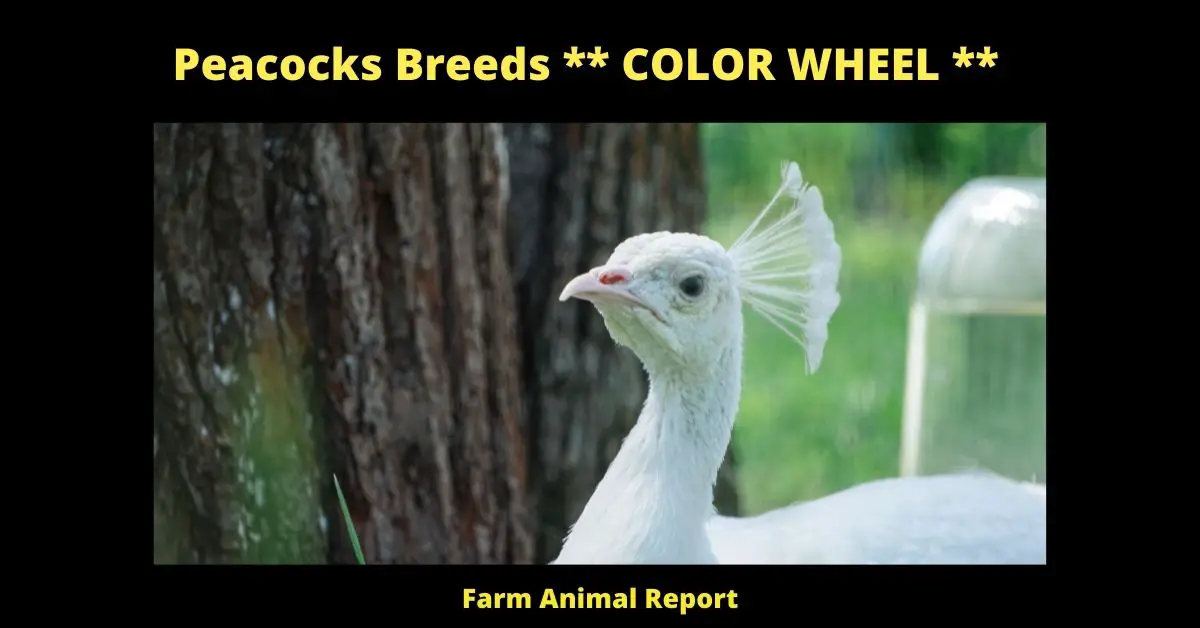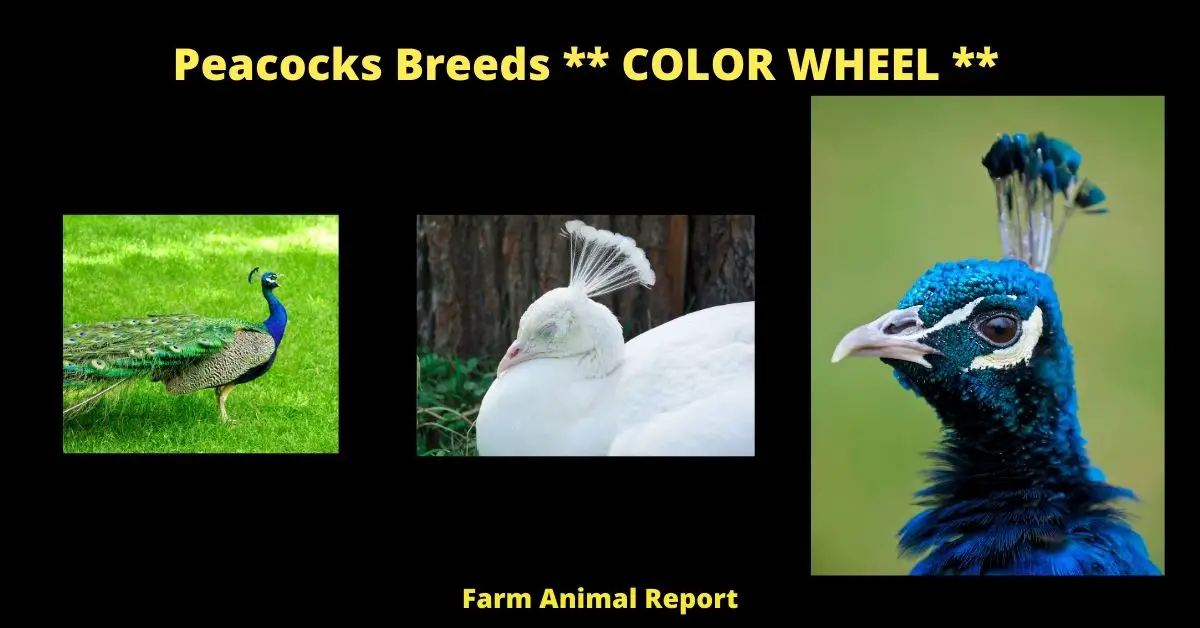Rare Peacock Colors – For a good reason, peacocks are considered to be “King of the Birds” in popular culture. Peacocks come in a wide range of color combinations and sizes, but there are only three unique species of Peafowl. Many distinct types of Peafowl are not found in the United States, but the United States is at the vanguard of the development of new color variant United Peafowl Association acknowledges 225 distinct Peafowl species at this time, according to their website.Peacocks Different Colors
Rare Peacock Colors – Peacocks Breeds – Peacock Colors
The United Peafowl Association acknowledges 225 distinct Peafowl species at this time, according to their website. Peacocks are renowned for their stunning tail feathers, vividly colored heads, and distinctive voices, making them unquestionably one of the most startlingly attractive birds in the world.
Peacocks are the male form of a group of birds known as “Peafowl,” whereas Peahens are the female version of the same group of birds. What are Different Colored Peacocks
Peacocks Breeds – Peafowls are members of the pheasant family, and they are native to Asia and Africa. They are one of the biggest kinds of flying birds, with a wingspan of up to 20 feet. Various terms for a group of Peafowl include “ostentation,” “party,” “bevy,” and “pride.”
If You would Like to add to Your Peacock Raising Library Check Out These Great Books on Amazon
Peacocks are frequently polygamous, having a harem of two or three Peahens, and Peahens are also polygamous. Peafowls are omnivorous, consuming a variety of insects, frogs, lizards, seeds, plants, flowers, and other small animals.
Jump to 10 Ways to Make **MONEY** Peacock Farming
Let’s have a thorough look at Peacock breeds.

1. Indian Peacock – Color
In addition to being the most well-recognized peacock species, it is also the most endangered. The Indian Peacock is endemic to India, Sri Lanka, and other countries of eastern Asia. The peacocks of this species are distinguished by their distinctive tail plumage, which is employed in courtship rituals, as well as their brilliant blue heads and crest colorings. ( Peacocks Different Colors)
The Peacock’s vivid colors and huge tail feathers are utilized to attract peahens and to compete with other peacocks for territory and size. When caring for peachicks hidden among shrubs or vegetation, Indian peahens have a subdued brown hue with green or blue heads and smaller tail parts that serve as concealment.
According to Hindu legend, peacocks have the feathers of angels, the voice of devils, and the stride of a robber. Their eye-catching plumage is partly eclipsed by their obnoxious and aggressive cry, which can be deafening at times, and they certainly have a stealthy gait!
2. Green Peacock or Javanese Peacock – Bird
The Javanese Peacock, commonly known as the green Peacock, is a Peacock species indigenous to the Indonesian island of Java in Southeast Asia. They are comparable to Indian peacocks in that they have huge, vividly colored trains and utilize their feathers in courtship rituals, which is similar to that of Indian peacocks.
Peacocks with green heads and crests are distinguished from Indian peacocks by the vivid green hue of their heads and crests rather than the blue of their bodies. Green peahens are likewise vividly colored, with green tones that are only somewhat more subdued than those of their male counterparts. Unlike Indian peahens, however, the green species does not have a lengthy train of tail feathers, as does the Indian kind.
Peacocks Different Colors – The Green Peafowl is the most silent or mute of the Peafowl breeds, and despite its huge size, it is a robust bird capable of long flights. It is the most silent of the Peafowl breeds.
Their size is comparable to or greater than that of the Indian Peacock, and their tail is even longer than that of the iconic Indian Peacock. In the unfortunate event that the Green Peafowl becomes extinct, the species has been designated as endangered since 2009.
3. Congo Peacock – Iridescent
The Congo peacock, a relatively recent discovery, is an African native that more closely resembles regular pheasants than its flamboyant peacock cousins in terms of appearance. The males are of lesser height as compared to the females since they lack extended, vividly colored trains and are painted a bright blue.
The peahens of the Congo are mottled green and brown in color, and they look similar to immature versions of green or Indian peacocks in their appearance. Even though little is known about the critically endangered Congo peafowl, the Association of Zoos and Aquariums has established a program to assist in the preservation and maintenance of their habitat and populations.
Peacocks Breeds and Colors Variations – Shoulder – Silver – Black
Today’s different variations in peacock colors have developed due to selective breeding and mutations. The Indian and green Peacock are two-parent categories from which all others arise.
For example, the white Peacock is not an albino but rather a result of leucism (diminishment of skin and feather colors), and it is completely white from crest to train, unlike other peacock species.
Among the other breeding, varieties are peacocks that are black, brown, yellow, and purple in color; all of these colors are simply variations or mutations from the basic green or Indian Peacock. Peacock feather colors, making a colorful peacock,
Peafowl Colors
Peafowls have fifteen distinct colors: purple, Sonja’s Violeta, blue, cameo, green, white, charcoal, bronze, opal, peach, hazel, jade, midnight, taupe, and indigo.
Along with different color combinations, five distinct body patterns are recognized in peacocks that include the following:
- Pied
- Barred wing
- White-eyed
- Silver pied
- Black shoulder
These all different color and pattern combinations make it possible for Peafowl to have 225 different types in the present day.

Peafowl Varieties
Peafowl variants comprise all possible combinations of types, colors, and patterns. Each unique mix of species, color, and pattern results in the creation of a new variety of Peafowl.
For instance, the India Blues is one variation of Peafowl, the Whites are another, the Cameo Pieds are another, the three subspecies of Greens are all regarded as distinct varieties, and the crossing between the Indian Blue and the Green breed results in a variety of Peafowl. The two wild peafowl species, India Blue and Green, were naturally the first two types of Peafowl.
Whether color or pattern, dozens of new peafowl kinds become conceivable with each new mutation.
The following are the most popular varieties.
- Spalding Peafowl
The Spalding Peacock, created by crossing the Indian and Java Peafowls. It is almost similar in color to the Java Green but has a thinner, longer body that is significantly bigger than the Indian Blue. The Spalding Peahen is much more vibrantly colored than the Indian Peacock, with a much more pronounced green neck and head colors.
Spalding Peafowl newborns are often significantly bigger and darker in color than Indian chicks. Other variants of the Spalding Peafowl have been developed, including the following:
- Spalding Pied
- Spalding White
- Spalding Cameo
- Black Shouldered Peafowl
The Black Shouldered Peafowl was created due to mutation of the Indian Peafowl. It is one of the most frequent kinds of Peafowl. The primary contrast between this variation and the Indian Peafowl is the wing coloration:
The simple black wings of the Black Shouldered Peafowl have a green/blue shine. A single recessive gene causes the coloring of the bird. Additionally, the Peahens are stunningly lovely and distinct from the Indian version.
They are normally cream in color with a green sheen; however, the color of females varies considerably. Some are substantially deeper in hue, ranging from cream to brown, while others are pale cream.
- White Peafowl
Peacocks Different Colors – Contrary to common perception, White Peafowl are not albinos but a color mutation of the Indian Blue Peafowl. They are white owing to a lack of pigment in their DNA but are not classified as albinos since their loss of pigment is restricted to their feathers alone; they retain color in their eyes.
These birds were the first to be recognized as having a color mutation. They were discovered in the wilds of India.
Certainly! Here are brief explanations for each of the suggested topics along with a couple of well-researched paragraphs for each:
Peacock Color Genetics
Understanding peacock color genetics involves delving into the inheritance patterns of color traits in peafowls. Peacock feathers display vibrant colors due to the presence of pigments and structural coloration. Researchers have identified various genes responsible for coloration, including the Eumelanin and Pheomelanin genes, which regulate the production of black and red coloration in feathers.
The interplay of these genes results in the stunning array of colors seen in peacock plumage. Additionally, understanding the genetics can aid in selective breeding programs to produce specific color variations. In recent genetic studies, scientists have uncovered the complex interactions between different genes that control the expression of colors in peacock feathers. These findings have practical applications for breeders and conservationists, helping them preserve and potentially enhance the diversity of peacock colors within captive populations.
Natural Habitat and Behavior of Peacocks:
Peafowls are native to South Asia and parts of Africa, and their natural habitat plays a crucial role in their behavior and coloration. They are often found in forested areas and open grasslands. Understanding their habitat helps explain their natural behaviors, such as foraging, roosting, and mating rituals.
The vivid colors of peacock feathers serve multiple purposes, including attracting mates and establishing territory. Furthermore, their ability to blend into their surroundings aids in predator avoidance. In India, for instance, the Indian Peafowl, also known as the Indian Peacock, thrives in a variety of ecosystems, from dense forests to agricultural lands.
These habitats influence their adaptability and behavior. In the wild, peacocks are known for their impressive courtship displays, where they fan their colorful plumage and emit loud calls to attract peahens.
Evolution of Peacock Colors:
Peacock colors have evolved over millions of years, shaped by natural selection. The striking iridescence of peacock feathers serves not only as an aesthetic feature but also as a survival mechanism. The shimmering hues and patterns play a role in courtship displays and mate selection. The evolution of these colors is driven by the reproductive advantage they provide, with brighter and more intricate displays often leading to increased mating success.
The intricate interplay between genetics and sexual selection has resulted in the diversity of colors we see today. Fossil evidence suggests that the ancestors of modern peafowls existed in the Pleistocene epoch, and the evolution of their colors likely began with the development of iridescent feathers. As they adapted to different environments and ecological niches, the colors diversified, reflecting both ecological and social factors.
Human Interaction with Peacocks:
Human interaction with peacocks encompasses various aspects, from domestication for ornamental purposes to their role in zoos and wildlife sanctuaries. In some cultures, peacock farming is a lucrative business, with peacock feathers and even the birds themselves being sought after for their aesthetic appeal. Zoos play a vital role in conservation efforts, raising awareness about peacock species and contributing to breeding programs to ensure their survival.
In the United States, for example, peacocks are often kept on private estates and farms for their striking appearance. They are sometimes used as “guard animals” to deter pests and intruders due to their loud calls and vivid presence. This human-peacock interaction showcases the cultural significance and economic value of these birds.
Conservation of Peacock Species:
Conservation efforts are crucial for preserving the various peacock species, especially those with rare and endangered color variations. Habitat loss, poaching, and illegal trade pose significant threats to peafowl populations. Conservation initiatives focus on protecting their natural habitats, enforcing wildlife protection laws, and breeding programs to increase the numbers of endangered species.
The Congo Peacock, known for its iridescent plumage and unique blue coloration, has faced habitat destruction due to logging and mining activities in the Congo Basin. Conservation organizations are working diligently to safeguard its habitat and ensure the survival of this striking and rare bird.
Peacock Color in Mythology and Religion:
Peacock colors hold deep cultural and spiritual significance in various mythologies and religions worldwide. For example, in Hinduism, the peacock is associated with deities like Lord Krishna, and its vibrant plumage symbolizes divine beauty.
In Greek mythology, the peacock is linked to the goddess Hera. Understanding these symbolic connections sheds light on the broader cultural importance of peacock colors. In Hindu mythology, the peacock is often depicted as a mount for Lord Murugan, symbolizing victory over ego and pride. The vivid hues of the peacock’s tail feathers are believed to represent the many colors of life.
Peacock Colors in Literature and Symbolism:
Peacock colors have inspired poets, artists, and writers throughout history. They have been used as symbols of beauty, royalty, and opulence. In literature, peacock metaphors often connote extravagance and grandeur. Exploring the rich literary and artistic symbolism associated with peacock colors provides insight into their enduring appeal.
In Oscar Wilde’s famous novel “The Picture of Dorian Gray,” the character Dorian Gray has a room decorated with peacock feathers, symbolizing his decadent and indulgent lifestyle. This literary reference underscores the association between peacock colors and luxury.
Use of Peacock Feathers:
Peacock feathers have been used for various purposes, from traditional rituals and costumes to interior decoration and fashion. Their iridescence and vibrant hues make them highly sought after for crafts, accessories, and even haute couture. Understanding the cultural and artistic significance of peacock feathers highlights their enduring popularity.
In Native American culture, peacock feathers have been used in traditional regalia, symbolizing spiritual connection and reverence for nature. Similarly, in Indian classical dance and ceremonies, peacock feathers are a common accessory, adding a touch of elegance and tradition.
Threats to Peacock Populations:
Peacock populations worldwide face a range of threats, including habitat destruction, hunting for their plumage, and capture for the pet trade. These threats can lead to declining numbers and endangerment of certain species.
Understanding the challenges they face is crucial for implementing effective conservation measures. In some regions of South Asia, habitat destruction due to urbanization and agriculture has led to a decrease in peacock populations. Additionally, the illegal trade of peacock feathers for decorative purposes poses a significant threat to these birds.
These paragraphs should provide a comprehensive overview of the suggested topics for List 3, offering readers a deeper understanding of various aspects related to peacock colors and their significance.
Rare Types of Peacocks
Here are some of the rarest Peacock types/breeds:
- The Bornean peacock-pheasant (It is arguably the rarest and least known of all peacock species)
- White-Eyed Peafowl
- Silver Pied Peafowl
- Opal Peafowl
- Burford Bronze peafowl
- Cameo Peafowl
- Purple Peafowl
Peacock Facts – Peacock Colors | Peafowl
Interesting facts about peacocks are given here:
- Apart from its prominence as India’s national bird, peacocks have a place in Greek mythology as a sign of immortality, and the Ashkenazi Jewish people have golden peacocks as emblems of innovation. Peacocks were typically portrayed in early Christian mosaics and paintings, as the “eyes” on its tail feather were believed to symbolize the all-seeing God or the Church. Peacocks were connected with the Tree of Life in ancient Persia.
- Peacocks naturally lose their feathers each year following mating season, at which point they can be collected by people interested in maintaining a collection of the colorfully patterned plumage.
- Even though their tail feathers are large and heavy when unfolded, they give the fan configuration.
- Peacocks frequently fly short distances to avoid predators or to nest at night.

How many Different Colors of Peacocks are There
The peacock is a beautiful bird that is known for its colorful tail feathers. The colors of the peacock tail feathers are blue, green, and purple. These colors are created by the reflection of light off of the pigments in the feathers.
The peacock’s tail feathers are also covered in a layer of transparent fibers, which helps to create the colorful patterns that are seen in the tail feathers. The peacock’s head and body are usually a dull green color, with some brownish-colored spots.
The peacock’s neck is usually a bright blue color. The peacock’s beak is yellow, and the legs and feet are grey.
Basic Colour of Peacock – Peafowl
The bird that I am going to discuss is the peacock also known as the peafowl. The males and females of this species are different in their plumage. The adult male has long, erect schools, tail feathers that have an eye at the end of each feather, and blue-green body plumage.
On the other hand, the adult female has a much shorter train of feathers and green body plumage with some copper hues. There are three main types of peacocks- the Indian Peacock, Green Peacock and Congo peafowl.
The Indian peacock is found in India and Sri Lanka and is the national bird of both countries. It is considered sacred in Hinduism and is often seen in temple artworks and sculptures.
The Green Peacock is found in Java and Burma while, the Congo peafowl is found in Central Africa. All three species have green plumage but differ slightly in coloration and size. Peacocks are usually silent birds but make loud calls especially during mating season.
Out of all the interesting facts about peacocks, did you know that their diet consists mainly of snakes? Yes, you read that right! These gorgeous birds help keep the snake population under control. So, not only are they beautiful to look at but also play an important role in our ecosystem.
What are the most Common peacock color combination?
The three most common colors for peacocks are blue, green, and white. However, there is a wide range of color combinations that can be found in nature. For example, some peacocks have feathers that are entirely blue, while others have a mix of blue and green feathers.
In addition, some peacocks have white plumage with blue or green markings. The vast majority of peacocks have colorful tails, but there are a few rare exceptions where the tail is entirely white. Regardless of the color combination, all peacocks are beautiful and unmistakable creatures.
Other Thoughts
- rare peacock colors
- what color are peacocks
- different peacock colors
- what colors do peacocks come in
Peacock Colors: The 2023 Guide to Nature’s Most Mesmerizing Display 🦚
Peacock Colors 🦚
You might think that peacocks are all about show and no substance, but you’d be wrong. These colors are not just for show; they’re the result of complex biological processes. Each feather is a marvel of microstructure, reflecting and refracting light to create those dazzling colors we see. It’s all thanks to layers upon layers of microscopic plates on each feather, which scatter light to produce these beautiful colors. So the next time you find yourself staring at a peacock, remember, you’re not just looking at nature’s eye candy—you’re looking at a biological masterpiece.
Peacock Colors and Parent Breeding Characteristics: A Handy Table 🦚🌈
Hey there, bird enthusiasts and color lovers! If you’re interested in how different peacock colors come to life through breeding, you’re in the right place. Below, I’ve put together a handy table that outlines various peacock colors and the parent breeding characteristics needed to achieve those magnificent hues. Take a look!
| Peacock Color | Mother’s Characteristics | Father’s Characteristics | Likelihood | Notes |
|---|---|---|---|---|
| Blue and Green | Indian Blue Peafowl | Indian Blue Peafowl | High | Most common and easy to breed. |
| Leucistic White | Partially leucistic Indian Blue or White Peafowl | Partially leucistic Indian Blue or White Peafowl | Low | Genetic mutation causes this rarity; not to be confused with albinism. |
| Pied | Pied Indian Blue Peafowl | Pied Indian Blue Peafowl | Moderate | Marked by patches of white and another color. |
| Spalding | Green Peafowl | Indian Blue Peafowl | Moderate | A hybrid with a mix of colors from both parents. Named after Mrs. Keith Spalding. |
| Black Shoulder | Indian Blue Peafowl with black shoulder trait | Indian Blue Peafowl with black shoulder trait | Moderate | Dominant gene from both parents results in this unique coloring. |
| Palawan Blue | Palawan Peafowl | Palawan Peafowl | Low | Very rare and specific to the Palawan Islands. |
| Bronze | Green Peafowl with bronze mutation | Green Peafowl with bronze mutation | Low | A rare mutation that results in a stunning bronze sheen. |
| Java Green | Green Peafowl | Green Peafowl | Moderate | Native to the island of Java, Indonesia. |
| Cameo | Cameo Peafowl | Cameo Peafowl | Low | Known for their soft, beige and brown tones. |
A Few Friendly Notes 📝:
- Blue and Green: These are the colors you’ll most often spot at a zoo or even at some farms. They’re quite common but no less beautiful!
- Leucistic White: These ethereal beauties are incredibly rare and are not albino. The blue eyes give them away!
- Spalding: A rich tapestry of colors thanks to the hybrid nature of their lineage, these birds are often a focal point in aviaries.
- Black Shoulder: Black-shouldered peacocks possess a dramatic contrast of color that makes them quite unique.
- Palawan Blue: These are the unicorns of the peacock world. Seriously, if you ever spot one, consider yourself super lucky!
- Bronze: If you ever spot a bronze peafowl, be sure to capture that magnificent shimmer in a photo!
- Java Green: Native to Java in Indonesia, these peafowls are known for their intense green plumage.
- Cameo: These are for those who appreciate the softer, earthy hues in life.
I hope this table helps shed some light on the magical world of peacock breeding. Whether you’re an aspiring peacock breeder or just a fan of these splendid birds, this guide should offer some colorful insights. Isn’t nature awesome? 🦚🌈
Rare Peacock Colors 🌈
Not all peacocks are created equal—at least, not in the color department. While we’re used to seeing the common blue and green hues, there are some rare colors out there that are nothing short of spectacular. 🌈
What is the Rarest Peacock Color? ❓
Ready to be amazed? The rarest peacock color is the leucistic white peacock. Unlike albinos, these white peacocks are not devoid of pigment. They still have blue eyes and color but have a genetic mutation that results in their unique appearance. Finding one is a bit like striking gold; it’s an awe-inspiring sight, and it’s quite rare!
A Step-By-Step Guide to Breeding Leucistic White Peacocks 🦚👩🌾
Hey there, aspiring peacock breeder! If you’re aiming for the stunningly ethereal leucistic white peacock, you’ve got quite an ambitious goal, but don’t worry—I’m here to guide you through the process step by step. Let’s dive in!
Step 1: Understand the Genetics 🧬
First things first, it’s important to note that leucistic peacocks are not albinos. Albinos lack pigmentation altogether, while leucistic peafowls have some colored pigment, usually evident in their eyes. Understanding the genetic basis can give you a clearer path to your goal.
Step 2: Choose the Right Pair 🕊️🕊️
This is perhaps the most crucial step. You’ll need to start with at least one parent that carries the leucistic gene. Ideally, both parents would carry this gene to increase the odds. Leucistic peafowls are rare, so you might need to consult specialized breeders or geneticists to source them.
Step 3: Create the Ideal Environment 🌳
Peafowls need space to roam, shelter from the elements, and a balanced diet. The healthier the birds, the better the breeding results.
Step 4: Monitor the Peafowls 🌡️
Keep an eye on the birds to ensure they’re healthy and getting along well. You’ll want to watch for signs of illness or stress, as this can affect fertility.
Step 5: Initiate Breeding Season 🗓️
Peafowls generally breed in the spring. During this time, make sure to provide high-protein food and lots of fresh water. The male will display his feathers as part of the mating ritual, so keep your camera handy for that spectacular moment!
Step 6: Egg-laying & Incubation 🥚🐣
After successful mating, the hen will lay eggs. You can either allow the mother to incubate the eggs naturally or use an incubator set to around 99–100°F (37–37.8°C) with 50-60% humidity.
Step 7: Chick Rearing 🐥
Once the eggs hatch, you’ll have to be attentive in feeding the chicks and keeping them warm. Specialized peafowl chick food is available, rich in protein to support their growth.
Step 8: Genetic Testing 🧪
If you’re serious about confirming the leucistic trait, consider genetic testing when the chicks are old enough. This will confirm whether or not they inherited the gene.
Step 9: Continue Breeding 🔄
Breeding leucistic white peacocks is an ongoing effort that may require several generations for the trait to consistently appear.
Step 10: Share Your Success 🌟
Once you’ve successfully bred a leucistic white peacock, consider sharing your insights and maybe even birds with other breeders to help this rare and beautiful variety become more common.
And there you have it! A step-by-step guide to breeding leucistic white peacocks. It’s a challenging but incredibly rewarding endeavor. Remember, breeding these unique birds is part art, part science, and a whole lot of patience. Good luck! 🦚🌈
What is a Rare Breed of Peacock? 🦚
The Spalding peacock is another rare gem. Named after Mrs. Keith Spalding, who was among the first to breed them, these birds boast an exotic mix of colors from the Green Peafowl and the Indian Blue Peafowl. The resulting offspring feature an extraordinary blend of colors, making them a prized breed among peacock enthusiasts.
Can You Get a Purple Peacock? 🟣
Ah, the stuff of legends—a purple peacock! While no pure purple peacock exists, selective breeding and specific lighting conditions can give peafowls a purple-ish tint. These are not genuinely purple but rather an optical illusion, a trick of the light, if you will. Nevertheless, it’s a captivating sight and a dream come true for those in search of something truly unique.
What is the Most Valuable Peacock? 💎
If peacocks were the currency of the natural world, the Palawan Peacock would be the gold standard. Found only on the Palawan Islands of the Philippines, these birds are both incredibly rare and stunningly beautiful, with vivid blues unlike any other. Because of their limited habitat and breathtaking colors, they are considered the most valuable.
Fascinating Facts About the Palawan Peacock 🦚🌴
Hey, friend! If you’re curious about the Palawan Peacock, also known as the Palawan Peacock-Pheasant, you’ve come to the right place. This beautiful bird is native to the Palawan Islands in the Philippines and is a true gem of the avian world. To make it easy for you, I’ve organized a table full of quick facts. Let’s take a look!
| Fact Category | Fun Details |
|---|---|
| Scientific Name | Polyplectron napoleonis |
| Family | Phasianidae |
| Native Habitat | Palawan Islands in the Philippines |
| Status | Vulnerable, according to the IUCN Red List |
| Diet | Omnivorous—eats seeds, small insects, fruits, and plant material |
| Size | Approximately 20 inches (50 cm) in length |
| Weight | Around 1–1.2 lbs (450–550 grams) |
| Coloration | Males have iridescent blue-green and black feathers, with a white crest; females are less colorful and more camouflaged |
| Life Expectancy | Up to 15 years in the wild; longer in captivity |
| Mating Behavior | Males perform courtship displays using their intricate plumage |
| Egg-Laying | The female lays 2-3 eggs, which she incubates for around 20 days |
| Conservation Efforts | Protected areas in Palawan, but still threatened by habitat destruction and illegal pet trade |
| Fun Fact | The male’s tail feathers can be longer than its body length! |
| Local Name | “Tandikan” in the Palawano language |
I hope you found this table informative! The Palawan Peacock is as intriguing as it is beautiful, and every effort should be made to protect this amazing bird. Happy birdwatching! 🦚🔍
Cultural Significance of Peacock Colors 🎭
Peacocks aren’t just a visual feast; they’re also deeply embedded in various cultures. In Hinduism, the peacock is associated with the goddess Saraswati, symbolizing wisdom, beauty, and knowledge. In China, peacocks are a symbol of dignity and beauty. So wherever you go, these birds are not just a pretty sight but a cultural icon.
Countries Where Peacocks Have a Cultural Connection 🦚🌏
Hey there, friend! You’re interested in the cultural significance of peacocks around the world? Awesome! Peacocks aren’t just pretty faces; they hold deep-rooted meanings in various cultures. From representing royalty to being considered sacred, these magnificent birds have made their mark. So, let’s dive right into a table listing countries where peacocks have a fascinating cultural history. 🌟
| Country | Cultural Significance |
|---|---|
| India | In Hinduism, the peacock is associated with Saraswati, a deity representing patience, kindness, and compassion. Also, the peacock is the national bird of India. |
| Sri Lanka | The peacock holds cultural significance as a symbol of beauty and grace. Some traditional dances also incorporate peacock motifs. |
| Myanmar (Burma) | In Burmese culture, the peacock is seen as a symbol of the sun and is often related to Burmese royalty. |
| China | The peacock symbolizes dignity and beauty in Chinese culture. It is also a sign of good fortune and rank. |
| Greece | In Greek mythology, the peacock is linked with Hera, the queen of the gods. Its tail feathers were considered a symbol of the “all-seeing” eyes. |
| Iran/Persia | The peacock is considered a guardian and is often found in ancient Persian art. It symbolizes immortality and is associated with royalty. |
| Indonesia | The peacock is highly regarded in Balinese Hinduism, and it’s often used in art and religious rituals. |
| Japan | While not as prominent as in other cultures, the peacock in Japan symbolizes love, goodwill, nurturing, and a kind heart. |
| Roman Empire | During Roman times, the peacock was a symbol of immortality and was sacred to Juno, the protector and special counselor of the Roman state. |
| Egypt | While not native, peacocks were imported to ancient Egypt and were considered a symbol of the starry firmament. |
| England | In the medieval and Renaissance periods, peacocks were a status symbol and often present in menageries and coats of arms. They were considered a sign of vanity and sometimes associated with the Resurrection. |
| Islamic Culture | The peacock appears in some Islamic stories and is considered a creature of paradise. However, its vanity is often cautioned against. |
I hope this table feeds your curiosity! Isn’t it fascinating how one bird can mean so many different things to so many different cultures? Enjoy exploring the world of peacocks! 🦚🌍
Symbolism in Peacock Colors 🔮
Each color in a peacock’s feather tells a story. Blue is often seen as a symbol of tranquility and calmness, whereas green represents growth and fertility. These aren’t just pretty feathers; they’re a language unto themselves, symbolizing concepts that resonate across cultures.
Peacock Colors in Art and Fashion 🎨
It’s hard not to be inspired by these magnificent creatures. From haute couture to home décor, peacock colors have left their mark. Their unique color palette has inspired countless designers, proving that nature is the ultimate muse.
Peacock Colors in Nature 🌳
While peacocks are native to South Asia and the Malay Archipelago, their colors seem to blend seamlessly into any natural backdrop. Whether it’s the lush jungles or the arid plains, peacock colors are always in perfect harmony with Mother Nature.
Whether you’re a bird lover, a fashionista, or just someone who loves to soak in the beauty of the natural world, peacocks offer something for everyone. Their colors are more than just eye-candy; they’re a complex tapestry woven by nature, science, and culture. So the next time you see those colors fan out, take a moment to appreciate the wonder that is the peacock.
Final Thoughts – Peacock Colors 🌟
Peacocks are flashy, colorful birds distinguished by their enormous tail plumes, vividly colored heads, and strong avian posture. Peacock’s male counterpart is known as Peafowl, while females are called peahens. They are well-known for their spectacular courtship display of billowing tail feathers covered in blue-green “eyes.”
Peacocks are famous for their colorful plumage. Peafowl is classified into three distinct species: Indian, Green, and Congo. They are easily identifiable by their color and size.





